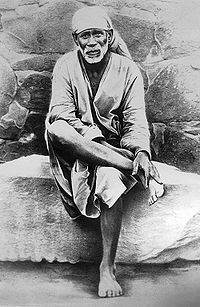Sai Baba of Shirdi
India 20th century | |
|---|---|
Shirdi Sai Baba sitting | |
Full name | Sai Baba of Shirdi |
Born | Unknown |
Died | |
School/tradition | |
Sai Baba of Shirdi (1838 – October 15, 1918), also known as Shirdi Sai Baba, was an Indian guru and yogi, regarded by his followers as an incarnation of God. Some of his Hindu devotees believe that he was an incarnation of Shiva or Dattatreya. Many devotees believe that he was a Sadguru. There are many stories and eyewitness accounts of miracles he performed. He is a well-known figure in many parts of the world, but especially in India, where he is much revered.
The name 'Sai Baba' is a combination of Persian and Indian origin; Sāī (Sa'ih) is the Persian term for "well learned" or "knowledgeable", usually attributed to Islamic ascetics, whereas Baba (honorific) is a word meaning "father; grandfather; old man; sir" used in Indo-Aryan languages. The appellative thus refers to Sai Baba as being a "holy father" or "saintly father".[1] His parentage, birth details, and life before the age of sixteen are obscure, which has led to a variety of speculations and theories attempting to explain Sai Baba's origins. In his life and teachings he tried to reconcile Hinduism and Islam: Sai Baba lived in a mosque which he called Dwarakamayi, practised Hindu and Muslim rituals, taught using words and figures that drew from both traditions and was buried in a Hindu temple in Shirdi. One of his well known epigrams says of God: "Sabka Malik Ek" ("One God governs all") which traces its root to Islam in general and sufism in particular. He always uttered "Allah Malik" - Lord is the sole protector. He had no love for perishable things, and was always engrossed in self-realization, which was his sole concern.
Sai Baba taught a moral code of love, forgiveness, helping others, charity, contentment, inner peace, devotion to God and guru. His teachings combined elements of Hinduism and Islam and tried to achieve communal harmony between these religions.
Sai Baba remains a very popular saint[2] and is worshiped by people around the world. Debate over his Hindu or Muslim origins continues to take place.[3] He is also revered by several notable Hindu and Sufi religious leaders.[who?] Some of his disciples received fame as spiritual figures and saints such as Upasni Maharaj and Meher Baba.
The name 'Sai Baba' is a combination of Persian and Indian origin; Sāī (Sa'ih) is the Persian term for "well learned" or "knowledgeable", usually attributed to Islamic ascetics, whereas Baba (honorific) is a word meaning "father; grandfather; old man; sir" used in Indo-Aryan languages. The appellative thus refers to Sai Baba as being a "holy father" or "saintly father".[1] His parentage, birth details, and life before the age of sixteen are obscure, which has led to a variety of speculations and theories attempting to explain Sai Baba's origins. In his life and teachings he tried to reconcile Hinduism and Islam: Sai Baba lived in a mosque which he called Dwarakamayi, practised Hindu and Muslim rituals, taught using words and figures that drew from both traditions and was buried in a Hindu temple in Shirdi. One of his well known epigrams says of God: "Sabka Malik Ek" ("One God governs all") which traces its root to Islam in general and sufism in particular. He always uttered "Allah Malik" - Lord is the sole protector. He had no love for perishable things, and was always engrossed in self-realization, which was his sole concern.
Sai Baba taught a moral code of love, forgiveness, helping others, charity, contentment, inner peace, devotion to God and guru. His teachings combined elements of Hinduism and Islam and tried to achieve communal harmony between these religions.
Sai Baba remains a very popular saint[2] and is worshiped by people around the world. Debate over his Hindu or Muslim origins continues to take place.[3] He is also revered by several notable Hindu and Sufi religious leaders.[who?] Some of his disciples received fame as spiritual figures and saints such as Upasni Maharaj and Meher Baba.













